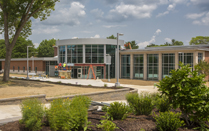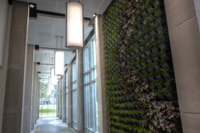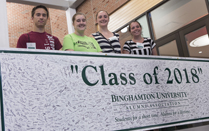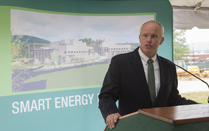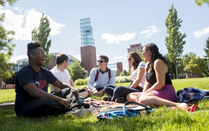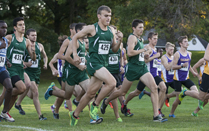Binghamton University President Harvey Stenger's Quarterly Report - September 30, 2014
If you’ve been following any of the daily photos on the University’s Web and Facebook pages, you’ll have noticed that it is a magical time of year on the Binghamton campus. I’ve really enjoyed the past few weeks on campus — I’ve met hundreds of new students and faculty, many of whom have been tempted by the warm afternoons to socialize, study or just soak up the sun in the Peace Quad and recreational fields. But, if the reds and purples of the maples and oaks in the Nature Preserve aren’t enough to remind us that the summer is over, the exams and projects under way certainly are.
For those of you who are engaged in the world of higher education, you’ll recognize that the higher education environment has its own weather patterns — some days are warm and sunny with easy access to resources and space for broad thinking. We are fortunate to be in such a time right now. But the environment can — and certainly will — change over time. Our goal, particularly with our Road Map, is to establish programs and initiatives that will enable the University to not only survive, but thrive when the weather changes.
I know that it is a popular misconception that the University basically shuts its doors during the summer — but the truth is, the summer quarter is when much of the heavy lifting gets done on campus. This has especially been the case this year, as we’ve worked to implement our Road Map, developed new academic programs and brought new facilities online to help us get our job done. At the same time, our faculty have been pursuing research and scholarship projects, and their achievements are garnering national recognition for the University, recognition that we’ve worked to leverage through new communications and outreach tools. These in turn have helped us increase enrollment, which is now at record levels. These changes necessarily bring some challenges — but generally of the good sort.
Start of the academic school year
At the end of August we welcomed 16,605 students for the fall 2014 semester: 3,279 graduate students and 13,326 undergraduates. Of these students, 2,531 freshmen, 1,168 transfer students and 1,388 graduate students are new to campus. These numbers are up from last year, particularly with regard to our graduate population.
Move-in day this year went exceptionally well, though we missed last year’s excitement of having President Obama on campus to start the semester. Residential life, University Police and other faculty and staff were exceptionally well-organized, helping to ensure that students were able to get into their rooms quickly and efficiently. Many of the parents compared our efforts favorably to different campuses attended by their other children.
Although enrollment continues to grow, we are committed to ensuring that student quality remains high. This year’s freshmen came with an average high school GPA of 94 and SAT scores in the 1300 range. We also remain a draw for international students, with more than 900 coming this year from 40 nations. This reflects both the growing reputation of our programs and our efforts to increase our reach into new student markets regionally, nationally and internationally.
Some of our newest students will be participants in a new Freshman Research Immersion Program designed to engage students in science, technology, engineering and mathematics (STEM). This project was a priority for us and received funding as part of last year’s Southern Tier Regional Economic Development Council award. It also has received support from the National Science Foundation, Howard Hughes Medical Institute and other agencies. Initially, it will involve 90 students in three STEM-related academic fields — chemistry/physics, biology and psychology — giving them authentic experience in “research streams” such as biofilms, neuroscience and smart energy. Eventually, we envision as many as 10 streams, with 300 freshmen participating during the fall and spring semesters and another 200 students in a summer immersion program. I believe there are numerous benefits to students who receive early training in research methods — it enhances critical thinking, develops teamwork and mentoring networks, turbocharges the educational process, and opens doors in academia and industry for talented students.
With the increase in enrollment comes a need for more faculty. This fall, 57 new faculty joined us as part of our NYSUNY 2020 commitment to increase faculty and research. Many of these faculty are teaching in areas related to our Transdisciplinary Areas of Excellence — research directions established specifically to meet the larger, interconnected challenges we face today.
This approach to research has helped Binghamton remain competitive in garnering research funding, despite a very challenging research environment. Despite the challenging national climate for research funding, Binghamton University reported expenditures of $31.7 million in 2013-14. That represents an increase of nearly 25 percent in the last 10 years. And we’ve worked to find other sources of research funding, especially by linking with industry and other non-governmental organizations. For example, in 2013-14, corporate partners funded 9.5 percent of sponsored research at Binghamton. That compares to about 5 percent of university R&D nationwide.
We’ve done well compared to many other institutions, and several of our faculty have recently received significant grants and awards recognizing their research interests and their
• Neuroscientist Sarah Laszlo, physicist Stephen Levy and computer scientist Timothy Miller have each received funding from the National Science Foundation’s Early Career Development (CAREER) Program, the agency’s most prestigious award for young researchers.
• Distinguished Professor of Psychology Linda Spear received an $8.2 million, five-year grant from the National Institutes of Health to support the Developmental Exposure Alcohol Research Center – a renewal of an $8.5 million grant awarded to the center in 2010. And the NorthEast Center for Chemical Energy Storage (NECCES) at Binghamton University, led by M. Stanley Whittingham, distinguished professor of chemistry and of materials science, has been awarded a $12.8 million, four-year grant from the US Department of Energy. The grant is one of only 32 DOE grants awarded for a total of $100 million to fund Energy Frontier Research Centers (EFRCs).
• Dean Krishnaswami “Hari” Srihari of the Thomas J. Watson School of Engineering and Applied Science was awarded the Michael P. Malone International Leadership Award for outstanding contributions to further international education in public higher education. In particular, he was recognized for his outreach to universities in China, Korea, Turkey, India and other nations. This is the second time Binghamton University has been recognized by the Association of Public and Land-grant Universities with this award; former President Lois DeFleur received one in 2007.
• And S.G. Grant, who has been dean of the Graduate School of Education (GSE) since 2008, resigned his position at the end of August to rejoin the faculty, where he will serve as principal investigator for a multi-million dollar grant from the New York State Education Department to create units for the state’s K-12 social studies curriculum. (Provost Donald Nieman has appointed C. Beth Burch to serve as interim dean, with a national search for permanent dean to follow.)
Recognition such as this helps strengthen our reputation for academic excellence and scholarly and research productivity. More important, it shows that Binghamton is an institution that embraces academic innovation and works to meet the changing needs of our students — and of society.
Rankings and reputation
Binghamton’s rising profile is also reflected in the annual rankings of colleges and universities put out by national publications such as U.S. News & World Report and The Fiske Guide to Colleges, with the former ranking Binghamton among the nation’s top 50 Universities — the 17th consecutive year we’ve made this list — and the latter naming us the 15th best value in the nation, making Binghamton a “Best Buy” in their eyes.
The importance and accuracy of these rankings is always a topic of debate among higher education leaders, as there is very little difference between being ranked 45th or 38th. Still, rankings often provide a starting point for families and students looking for a good college or University, so being ranked among the best schools in the nation is important to helping students become aware of us. But many of the factors that make Binghamton a great campus — things like study-abroad opportunities, the quality of student services or the sense of community that pervades the campus —can be overlooked by those who compile the lists, so we take these rankings with a grain of salt and tell students to really look at us because we will be a good fit, regardless of the metrics of any particular ratings.
Nonetheless, it is important that the Binghamton name be out there. With this in mind, we’ve recently bought time for a series of ads on WNYC, a New York City affiliate of National Public Radio. The purpose of this purchase is not only to attract potential students, but also to raise our visibility and reputation among parents and influencers of public opinion, such as industry leaders, people in the higher-education community and members of the media. All told, we have a series of four ads, each focusing on a different aspect of our education and research missions. (You can hear them online.) These ads will play twice daily for 20 weeks, reaching more than one million unique listeners each week in the New York City region — the largest audience of any NPR station in the United States.
Meanwhile, our communications team also has been working hard to convey important messages to the campus community. This is especially important for new students who are just getting acquainted with both the physical and cultural aspects of our campus. As part of this effort, I’ve made three videos to inform — and hopefully, guide — the newest members of the University. One video describes some of the events and activities that have kept us busy over the summer. Another welcomed students to campus on move-in day, and in the last, I urged students to make “Smart Choices.” I’ve been impressed by the response to these videos — it’s a fun way to reach out to students (and others), and hopefully, they may have more of an impact than another letter from the president’s office.
Construction
The summer also is a time when we make significant progress on the many construction projects taking place across campus. Larry Roma, our associate vice president for facilities management, likes to say that if there is green fencing up, things are going well. By these criteria, we are doing well indeed — and I think we will do even better with the appointment of JoAnne Navarro as vice president for operations. This is a crucial position on campus, overseeing not only campus construction, but several other areas of campus administration, including the human resources, information technology services, University Police and professional development functions.
Given the tremendous amount of work our admissions and student services offices do — last year there were more than 28,000 freshman applications — we decided that we needed a new facility to house these related services. This summer we completed work on the new Admissions Center (formerly Dickinson Dining Hall). The guiding vision behind this facility was to provide one-stop shopping for many of the services that students require — from admissions to the registrar to student accounts and financial aid. The building required extensive mechanical and electrical renovations, and it now boasts a biological filter “green wall.” Inside, the building itself is a marvel, with a large presentation room, classroom, modern offices and formal and informal meeting spaces, while attractive landscaping ties it to the University Union and Peace Quad.
Another campus project – the renovation of the Nelson A. Rockefeller Collegiate Center – will also help us better serve students. Renovation of the mechanical and HVAC systems is a foundational part of the project, but the building will also receive new ceilings, flooring, lighting and painting; a new classroom will be added and three exiting classrooms will be updated. When work is completed in March, 2015, the Binghamton Scholars will move into the lower level and have a space to call their own.
Also, in September, Lt. Gov. Thomas Duffy, as well as our New York State Senate and Assembly representatives, were on hand as we broke ground for our new Smart Energy Research and Development Facility. Funding for this project derives from the NYSUNY 2020 initiative, through which Gov. Andrew Cuomo and Chancellor Nancy Zimpher provided $35 million, which we matched to create this $70 million Smart Energy building. The building itself has been designed in-house by the University’s design team and meets LEED platinum standards for green building design — which is the ONLY way to design a facility for Smart Energy.
Faculty in this facility will focus on alternative energy production, harvesting and storage, looking at industrial and consumer technologies such as thin-film solar panel design and production, consumer-ready solar cells, increasing efficiencies in data collection centers and developing next-generation battery production. I believe that Binghamton is poised to become a leader in efficient, green and commercially viable alternative energy technologies, which will increase faculty access to federal, industrial and philanthropic grants as we gain a reputation for innovative research with real-world applications.
We also have completed our Center of Excellence Building and will be having a grand opening for the public on October 22. This $30 million facility, four years in the making, will provide space for the Center of Excellence in Small Scale Systems Integration and Packaging (S3IP). S3IP has several distinct research foci including component miniaturization, thermal management, energy optimization, and energy harvesting and storage technologies, and serves as an organizational umbrella for four organized research centers as well as the Analytical and Diagnostics Laboratory and the Nanofabrication Laboratory.
In a related project, we are moving forward on the Southern Tier High Technology Incubator located in downtown Binghamton. Although the University is technically the lead partner in this project, it really is the product of a great deal of collaboration between state agencies, SUNY — both in Albany and at the local level, industry, regional political offices, statewide economic development agencies including Gov. Andrew Cuomo’s Regional Economic Development Council and the federal Economic Development Administration.
We’ve finalized the interior design and let out bids for the initial concrete and steel work. When it is completed, it will include 12 office modules, 18 laboratories and a shared high bay space. We broke ground on the project on October 2, and expect to have the facility completed by fall 2016. The process has moved forward nicely, and I am deeply impressed by the cooperation that it has engendered between the University and community and business leaders.
But the biggest news of the quarter has to be the recent announcement of the siting for our new School of Pharmacy and Pharmaceutical Sciences. In September, Gov. Cuomo was on hand to announce that the school would be located on Corliss Avenue in Johnson City, near Wilson Hospital. Funding for the school is secure, with $10 million made available from the current state budget and a firm commitment from the governor’s office for the other $50 million.
We are in the initial stages of the design phase of the pharmacy building, having hired the architectural firm JMZ Architects and Planners, P.C. of Glens Falls, N.Y., to develop the program for the building. Members of the planning committee have been in close contact with the architects to identify program space needs. In order to understand the complexities of a pharmacy school facility, the committee has toured newly constructed pharmacy facilities at the University at Buffalo and D’Youville University to gain information to inform the discussion and the decision-making process.
Regarding the academic side of establishing a new school, we have begun the search for a founding dean of the School of Pharmacy and Pharmaceutical Sciences, having retained the an executive search firm of Storbeck/Pimintel & Associates, and have charged the search committee which is being chaired by Susan Strehle, dean of the Graduate School. We hope to conclude the search by January 2015.
This new project, one of the centerpieces of the Road Map, has generated a tremendous amount of interest, both on campus and in the local community, and we are all eager to get it up and running in the next three years.
Road Map proposals
We are now entering our second year of implementing the Road Map, with the areas of research, graduate and undergraduate education continuing to be the leading areas of investment. Over the summer, the Road Map Steering Committee completed its review of divisional proposals put forward for funding for the 2015-16 academic year. After combining several
proposals, the committee ranked a total of 54 proposals, with the top 10 receiving a portion of the $1.7 million base funding available.
With only these limited dollars available for the 2015-16 year, it is of course impossible to fund more than a few proposals. The steering committee selected proposals that match most closely with the University’s strategic priorities. In the end, the Steering Committee decided to fund the following proposals:
• Undergraduate and graduate recruitment
• PhD student support
• Binghamton Plus Program (formerly 4-1-1 Program)
• Academic Affairs staffing to meet enrollment growth
• Undergraduate Advising
• Transdisciplinary Areas of Excellence support
• Entrepreneurship and innovation partnerships
• A language center
• Faculty start-up supplemental support
• Office of Diversity, Equity and Inclusion staff support
Specific information on the proposals moving forward is available online and we will also jumpstart those projects that are ready for implementation now by matching up to $1 million in funding. In addition, there were a number of other proposals that just barely missed the cut; the provost and I are currently looking for other ways to fund some of these, including the use of private support where we find donors who share an interest in the general thrust of the proposal.
And, as we move forward, Provost Nieman and I are working with my senior staff to identify ways to more perfectly align all of our activities with our strategic priorities.
It’s been a very busy summer at Binghamton University; I appreciate the hard work that everyone has done to accomplish so much.
Sincerely,

Harvey G. Stenger

